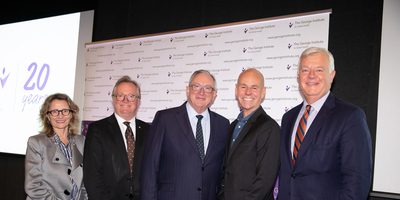
20 years of reducing treatment costs
One of The George Institute’s greatest global contributions to health care has been reducing the cost of treatments, according to Professor Norbert Berend.
A former member of The George Institute’s first Board, Norbert has closely watched the organisation’s growth and successes over the years. With a background in clinical respiratory medicine and research, and significant experience in medical and research administration, he was among its very early supporters.
“It was a very exciting time because we recognised the tremendous potential of the Institute, which was still in its infancy then, but was obviously headed for great things,” he recalls.
Now in the twilight of a highly distinguished career, Norbert recently completed a major respiratory study with the Institute involving approximately 2,400 patients across China and India.
The objective of the study, called TASCS, was to determine whether a relatively cheap treatment made a difference to patients with chronic obstructive pulmonary disease (COPD).
COPD is a respiratory condition that ranks amongst the top 10 causes of death in almost every country in the world. It is particularly prevalent in developing countries such as China.
"One consequence of COPD is that patients get exacerbations where breathing becomes extremely difficult – often due to respiratory infections," Norbert explains. "These exacerbations have a high mortality rate and reducing them is a major goal of current therapy. There are established successful therapies for reducing exacerbations, but they tend to be very expensive."
Norbert and his team set out to ascertain the efficacy of this much cheaper treatment in an ambitious trial across 48 sites throughout China. While the challenging study ultimately found the treatment to be categorically ineffective, its contribution to medical guidelines will be extremely valuable.
"These drugs are widely used in developing countries because they’re quite cheap,” he says. “Our research should stop countless numbers of patients receiving a useless treatment, which doesn’t have any benefit. It will save many developing countries an enormous amount of money that could be better spent elsewhere."
This approach to reducing the cost of treatment is something Norbert has witnessed the Institute do many times over the years. Indeed, he believes it is the Institute’s greatest contribution during its 20 years of research.
“There are many examples of this across different chronic diseases,” he says. “I think it’s a theme that runs through much of the Institute’s work – reducing unnecessary treatment costs and making sure that patients get cost-effective medications.”
Norbert cited the Institute’s groundbreaking work in simplifying dialysis treatment in the ACTIVE trial, and guideline-changing work on angiographies in the PRESERVE trial as further examples of generating evidence to streamline treatments and reduce associated costs.
Another example is a major study published in 2014, which found that paracetamol, the pain relief medicine that was universally recommended to treat people with acute low-back pain, does not speed recovery or reduce pain for this condition. The PACE study was the world’s first placebo-controlled trial for low-back pain and found the effect is the same whether paracetamol is taken regularly or as required, compared to a placebo.
“A lot of the Institute’s work in the intensive care sector has also been to debunk the use of really expensive or unnecessary interventions,” he says. “One key study showed that normal saline is as good as albumin in maintaining intravascular volume in an intensive care environment – albumin is very expensive while normal saline is very cheap. The salt substitution studies are similarly a relatively cheap innovation aimed at decreasing dietary salt intake to reduce hypertension, which will save huge amounts of money in treating strokes and associated complications.”
For Norbert, it’s this practical cost-effective approach to identifying and carrying out research that makes the Institute so unique.
“It's difficult to think of another institute which has had the impact on global health that The George Institute has had,” he says. “It really is outstanding both in the scope of the work it does and the benefits it's achieved for patients around the world.”
Celebrating 20 years: Norbert's top moments
- Help where it’s needed most: "I think the biggest contribution of the Institute has been finding low-cost therapies that can be applied to treat large numbers of people in low- and middle-income countries.”
- Changes to critical care: "The Institute has made an enormous contribution to critical care – and reducing its cost – and made sure that patients really get cost-effective medications."
- Excellence across the board: "With multi-disciplinary research institutes, it is seldom that there is the same quality of research across their various branches. But the Institute has maintained an extraordinarily high quality across all of its research endeavours."


